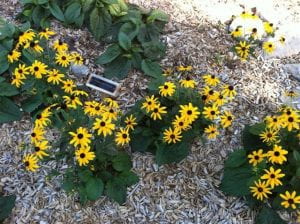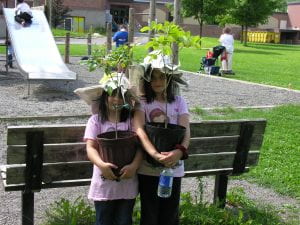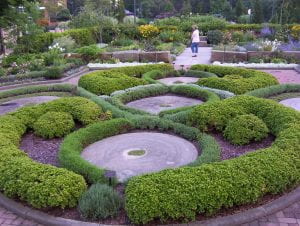Developing a Maintenance Plan 
What About Summer Care?
Keeping Everyone in the Loop
Documenting Efforts
Showing Your Appreciation
There is more to sustaining your garden than keeping the plants alive. Considering the time and resources invested, your garden program should serve as an education tool for this year’s community members and for community members using it 10 years from now. This section provides tips from experienced garden educators on how to sustain your garden efforts. Visit the Planning Your Design page for information about site selection, developing a garden design, and making the site accessible to all. Visit the Effective Community Engagement page for more information about successfully engaging with the community.
Developing a Maintenance Plan
- Help ensure garden sustainability with a Long-Range Maintenance Plan Activity (pdf).
- This Comprehensive Guide to Garden Maintenance (pdf) from The California School Garden Network, Gardens For Learning will help you keep your garden well-maintained.
- Use the School Garden Maintenance Schedule Template (pdf) from Grow to Learn NYC as a guideline.
Talk to people who have implemented community or school gardens, and ask them what was the biggest setback in their program. Many will say that they did not anticipate the level of maintenance required. Starting small, having a number of committed volunteers, and being very organized about the schedule for maintenance—who is responsible, and when—will minimize the demands.

Other matters to consider:
- In order to sustain the garden, your team must actively use the garden. If at all possible, plan garden time into the weekly schedule. While more time is ideal, even just an hour a week will have a dramatic effect on the gardens’ well-being and on the relationship with the garden.
- Encourage and invite youth groups and others to use the garden (after establishing some basic guidelines for use). Ask for and be open to ideas they may have. Perhaps there’s a way to incorporate garden produce into the school cafeteria or local food pantry.
These tools will help you integrate the garden into your daily curriculum:
- Curriculum Integration (pdf)
- Curriculum Mapping Activity for Science, Math, Language Arts and Social Studies (pdf).
- Curriculum Mapping Activity for Physical Education, Home and Careers and other Electives (pdf).
What About Summer Care?
A commonly asked maintenance question is, “How do we utilize or maintain our school garden during the summer?” First, is a garden needed during the summer months? Some programs simply plant a spring garden that comes to fruition by the end of June. An alternative is to plant fall crops, such as pumpkin or winter squash, which require minimal maintenance over the summer.
Often, teachers will ask the custodian or groundskeeper to care for the garden over the summer, but that does not capitalize on building ownership, and it might not be fair to the groundskeeper. Stories are told of situations in which the groundskeeper, out of frustration, “accidentally” leveled portions of the garden over the summer. So, alternative plans may work more smoothly. Of course, as a courtesy, let the groundskeeper know who will be on-site during the summer, regardless of what plan you choose.
The ideal summer program may be one in which the garden is well-maintained, is utilized for activities, and has solid leadership. 
Potential Alternatives:
- Ask the staff of a summer recreation program whether they would like to care for the garden, and simultaneously utilize it for activities.
- Put the garden up for “adoption.” Take a master calendar to faculty, PTA, and other meetings and events, and ask individuals and families to sign up for a period of days or a week. What are the rules for adoption? They can vary according to the garden’s requirements for maintenance, but the minimum is generally to show up daily and to be visible, especially in the evenings, so that the community (and potential vandals) can see that the garden is much loved and well cared for. Weeding and watering are other basic requirements. Some people also add deadheading, staking, removing spent stalks, etc. to the list. Let people know what is expected of them in advance, and indicate where the hose and tools will be stored.
- Form partnerships among agencies, such as school, cooperative extension service, youth bureau, and other community groups. For example, a group of 4-H clubs might be willing to care for a small school garden if they can use the garden for activities, utilize the produce, and display produce and flowers at a county fair.
When it comes to maintenance, remember that frequent care is very manageable—much easier than attacking knee-high weeds only occasionally. As always, many hands make light work. Refer to the Partnership and Ownership sections in the Before Getting Started page for more information about establishing partnerships and the importance of ownership.
Keeping Everyone in the Loop
It is critical to make everyone welcome. For example, groundskeepers at many institutions are the ones most attuned to the landscape around the facility, yet these VIP’s are often left out of the loop when it comes to the process of planning, designing, and implementing a garden project. Inform support staff, volunteers, assistants, and others who work behind the scenes of your intentions, and seek out their various viewpoints. Most of the common-sense solutions to daily questions and concerns will come from the people in the trenches.
Whenever possible, reach out and share the garden program with the community. Because of the nature of gardening, it really is easy to remind people that the program is alive and well.
- Send a thoughtful bouquet to the new business in town, to the foyer of the nursing home, or to the chamber of Commerce.
- Offer to take a tray of bite-sized fresh vegetables to a community event, and work with children to help prepare it.
- Plant extra plants for the hungry, and donate to the local soup kitchen or food pantry. Participants might even prepare a meal form the produce they have grown, or festoon the tables with their flowers.
- Never provide blimp-sized zucchinis, wooden carrots, or tired lettuce. Anything that leaves the garden and travels into the community is representing your organization and should be top-notch.
Increased involvement will add value to its role as an educational tool. To use the garden effectively, make sure to match lessons and activities with your curricular goals, adopt good outdoor classroom management techniques, create measurements for success, and document all your efforts.
Documenting Efforts
In the midst of an active garden program, it is easy to neglect the job of recording your efforts. But keeping track of your progress is critical. You will draw on this documentation as you share your work with administrators, community members, look for additional funds, and recruit new volunteers.
- Keep a notebook of your activities with detailed descriptions and photos.
- Track all donations of funds and materials along with the names and contact information of the donors.
- Log volunteer hours you and others put into the project, or better yet, give each volunteer a log sheet to keep track of their own hours.
- Log all the positive feedback you receive from youth, families, and community members.
- Take a lot of photos! Perhaps there is a volunteer willing to be the garden photographer, or if the budget allows, give each participant a disposal camera.
Visit our Evaluation Toolkit to learn new methods of collecting data and assessing your garden program’s impact.
Showing Your Appreciation
When all is said and done, there are probably a large number of people who have contributed to the success of the program. Never be miserly with gratitude. The planning committee may want to designate one individual to send thank-you notes to each person who has donated to, volunteered for, or otherwise shown support for the program. If the numbers are large and this is difficult, hold an event, such as a gardening lecture or workshop, and open it to all who are interested as a way of providing a public thank you. Be sure to invite all your benefactors. 
Ways to share your program and show appreciation:
- Donate produce to the local food pantry or soup kitchen
- Take flowers to nursing homes, libraries, and other community centers
- Offer to set up an exhibit in a high-profile location such as a community center or bank, describing how the planning committee set up the program, and the exciting things that are happening there now
- Provide refreshments for hard-working volunteers
- Remember that letters of thanks that include quotes form the participants are especially thoughtful
- Be sure to thank foundation and corporate supporters immediately
- Hold a special harvest dinner for volunteers and donors
- As your project grows, keep supporters updated with a gardening program newsletter




